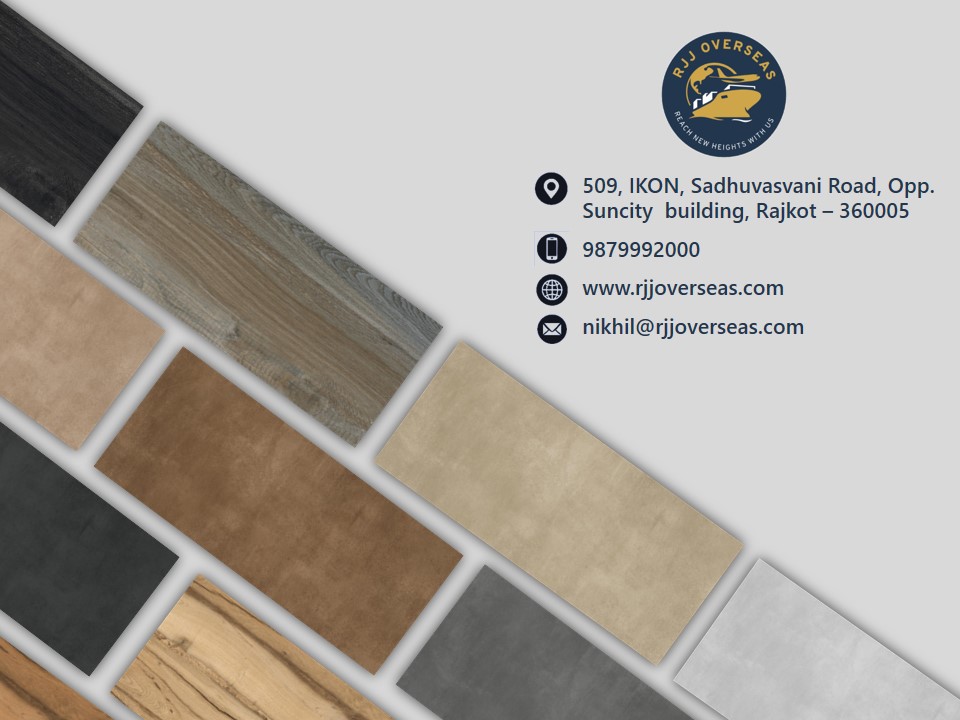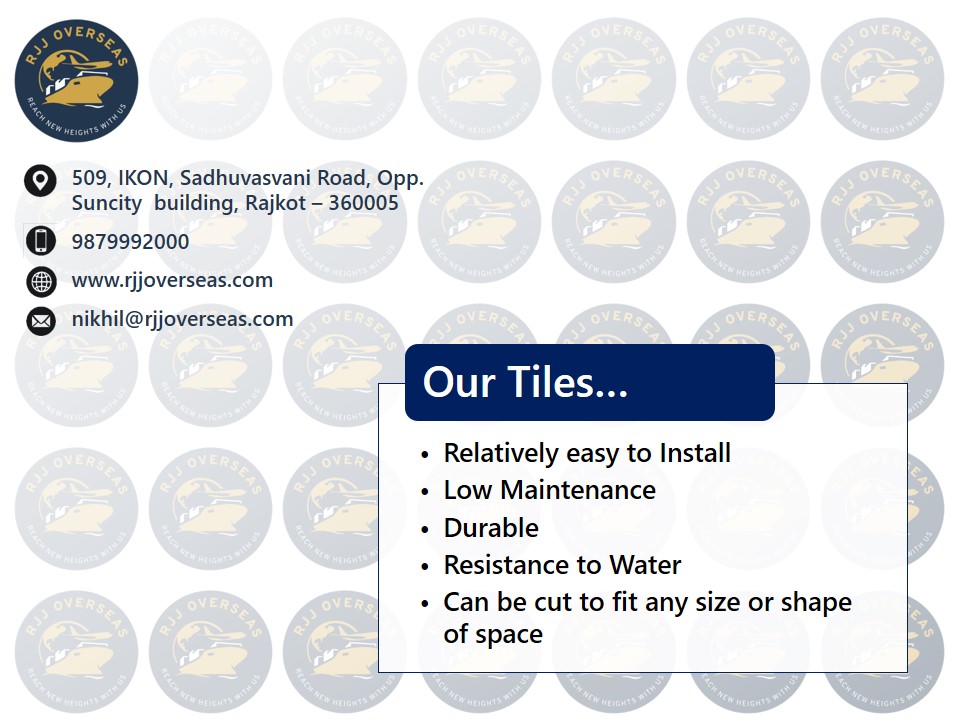India's ceramics industry has emerged as a major contender in the global porcelain, vitrified, and wall tile market, exhibiting impressive growth in recent years. This blog delves into the immense potential of India's ceramics industry while placing importers' interests at the forefront. By highlighting the benefits of sourcing ceramics from India and providing valuable insights into future prospects, we aim to establish India as a dominant force in the global market.

Overview of India's Ceramic Industry:
India's ceramics industry is experiencing significant growth and has become a prominent player in the global market for porcelain, vitrified, and wall tiles. Here is an overview of the industry, including its current market size, growth rate, major players, and the driving factors behind its development:
Current Market Size: The ceramics industry in India has witnessed substantial expansion in recent years. According to industry reports, the market size of India's ceramics industry was valued at USD 3.7 billion in 2020 and is projected to reach USD 10.5 billion by 2026, growing at a compound annual growth rate (CAGR) of approximately 15%.
Growth Rate: India's ceramics industry has been experiencing a robust growth rate, fueled by increasing domestic demand and growing exports. The industry has shown resilience even during challenging economic conditions and has consistently outperformed expectations.
Rich Reserves of Raw Materials: India boasts abundant reserves of raw materials necessary for ceramic production, including clay, feldspar, quartz, and other minerals. These resources provide a competitive advantage, ensuring a steady supply and reducing dependence on imports.
Technological Advancements: The Indian ceramics industry has embraced technological advancements to enhance production capabilities and product quality. Manufacturers have adopted modern machinery, automation, digital printing, and advanced kiln technologies, leading to improved efficiency, precision, and innovative designs.
Major Players: India is home to several major players in the ceramics industry, including both large-scale manufacturers and smaller, specialized producers. Some prominent companies in the sector include Asian Granito India Ltd, Kajaria Ceramics Ltd, Nitco Ltd, Somany Ceramics Ltd, and Orient Bell Ltd. These companies have established a strong presence both domestically and internationally, catering to diverse customer demands.
Competitive Advantage of Indian Ceramics:
India offers several competitive advantages as a sourcing destination for porcelain, vitrified, and wall tiles. These advantages include:
a. Cost-Effectiveness: Importing ceramics from India provides cost advantages for international buyers. The country benefits from competitive labor costs, which contribute to lower production expenses. Additionally, India's ceramics industry has optimized its production processes, leveraging efficient manufacturing techniques and economies of scale to offer competitive pricing to importers.
b. Quality and Innovation: Indian ceramics manufacturers have made significant strides in producing high-quality products that meet international standards. They prioritize innovation in design, constantly evolving to cater to changing consumer preferences and market trends. Indian ceramics are renowned for their craftsmanship, attention to detail, and aesthetic appeal, making them attractive to importers seeking premium products.
c. Sustainable Practices: India's ceramics industry is committed to sustainable manufacturing practices. Manufacturers adhere to eco-friendly production processes, including waste management and energy-efficient techniques. Many Indian ceramic producers use recycled materials, reducing environmental impact. Importers looking for responsible sourcing can find assurance in India's adherence to global environmental regulations and the industry's focus on sustainability.

Infrastructure and Technology:
India's ceramics industry boasts a robust infrastructure and advanced technological capabilities, positioning it as a competitive player in the global market. Here are the key highlights:
Specialized Manufacturing Clusters: India has established specialized manufacturing clusters dedicated to ceramics production. Regions such as Morbi in Gujarat, Tiruchirappalli in Tamil Nadu, and Khurja in Uttar Pradesh have emerged as major ceramic manufacturing hubs. These clusters offer a concentration of ceramic factories, enabling synergies, knowledge sharing, and efficient supply chains.
Research and Development Centers: India's ceramics industry has invested in research and development (R&D) centers to foster innovation and technological advancements. These centers focus on developing new materials, improving manufacturing processes, and creating innovative designs. Notable R&D institutions include the Central Glass and Ceramic Research Institute (CGCRI) and various university-affiliated research centers.
Automation and Digital Technologies: The integration of automation and digital technologies has significantly enhanced the efficiency and productivity of India's ceramics industry. Manufacturers have adopted advanced machinery, including robotic systems and automated production lines, to streamline processes such as material handling, shaping, glazing, and firing. Automation reduces human error, increases precision, and accelerates production cycles.
Digital Printing: India has embraced digital printing technology in the ceramics sector. Digital printing allows for intricate and customizable designs, enabling manufacturers to meet diverse customer demands and create unique products. This technology offers high-resolution printing capabilities, faster turnaround times, and efficient use of resources compared to traditional printing methods.
Quality Control and Testing: India's ceramics industry emphasizes quality control through rigorous testing procedures. Manufacturers invest in quality control laboratories equipped with modern testing equipment to ensure compliance with international standards. These laboratories conduct various tests, including dimensional accuracy, strength, durability, and chemical resistance, to guarantee the quality of the final products.
Export Potential and Market Penetration:
India's ceramics industry exhibits strong export capabilities and is strategically targeting key regions and emerging markets to expand its global presence. Here are the key strategies and advantages that contribute to successful market penetration:
Branding:
Emphasize India's rich heritage, craftsmanship, and innovative designs.
Create a distinct brand identity that resonates with importers and reflects the industry's strengths.
Marketing Campaigns:
Utilize digital platforms, trade shows, and exhibitions to showcase the unique features and benefits of Indian ceramics.
Engage in targeted marketing campaigns to create awareness and generate leads.
Collaborations:
Form strategic collaborations with international distributors, retailers, and designers to access established networks and local expertise.
Collaborate with global partners to enhance market reach and build mutually beneficial relationships.

Cost-Effectiveness:
Leverage competitive labor costs and efficient production processes to offer ceramics at competitive prices.
Highlight the cost advantages of sourcing ceramics from India compared to other global suppliers.
Quality and Design:
Focus on producing high-quality ceramics that meet international standards and cater to evolving consumer preferences.
Showcase innovative designs that appeal to a wide range of customers and differentiate Indian ceramics in the global market.
Emerging Markets:
Target emerging markets such as the Middle East, Africa, and Southeast Asia due to their rapid development, infrastructure projects, and demand for affordable ceramics.
Tailor products and marketing strategies to suit the specific needs and preferences of these markets.
Key Target Regions:
Penetrate key regions like Europe, the United States, and the Asia-Pacific by highlighting the quality, cost-effectiveness, and design capabilities of Indian ceramics.
Build relationships with importers and retailers in these regions to expand market reach and distribution networks.
Government Initiatives and Support:
Government Initiatives and Policies Supporting India's Ceramics Industry
Tax Incentives:
Provide tax benefits, such as reduced excise duties and exemptions on specific inputs and machinery, to promote the growth of the ceramics industry.
These incentives lower production costs, making Indian ceramics more competitive in the global market.
Export Promotion Schemes:
Government schemes like the Merchandise Exports from India Scheme (MEIS) and the Export Promotion Capital Goods (EPCG) scheme offer exporters financial incentives and duty credits.
These schemes encourage ceramics manufacturers to focus on exports, enhancing the attractiveness of India as an exporting destination.
Research Grants and Development:
The government allocates funds for research and development (R&D) in the ceramics sector.
Research grants support innovation, technological advancements, and product development, fostering competitiveness and product quality.
Skill Development Programs:
The government implements skill development programs to enhance the capabilities of the workforce in the ceramics industry.
Skill development initiatives ensure a skilled labor force, equipped with the necessary technical expertise, contributing to improved production processes and product quality.

Infrastructure Development:
The government invests in infrastructure development, including industrial parks and specialized zones for the ceramics industry.
These initiatives provide a conducive environment for manufacturers, improve logistics, and attract domestic and foreign investments.
Ease of Doing Business:
The government has implemented reforms to improve the ease of doing business in India.
Simplified procedures, streamlined regulatory frameworks, and digitalization initiatives make it easier for importers to engage with Indian ceramics manufacturers.
Future Trends and Opportunities:
Future Trends and Opportunities in India's Ceramics Industry
India's ceramics industry is poised for significant growth and can establish itself as a major player in the global market by capitalizing on emerging trends and opportunities. Several areas show immense potential for innovation and expansion:
Advancements in Digital Printing:
The adoption of advanced digital printing technologies allows for highly detailed and customizable designs on ceramics.
India's ceramics industry can leverage digital printing to offer a wide array of patterns, textures, and colors, catering to diverse customer preferences.
This trend opens up opportunities for personalized and unique ceramic products, enabling manufacturers to tap into niche markets and offer bespoke solutions.
Customization and Bespoke Solutions:
Rising demand for customized ceramics presents a significant growth opportunity.
Indian manufacturers can focus on providing tailored designs, sizes, shapes, and finishes to cater to individual customer needs and project requirements.
By offering customization, India can differentiate itself in the global market and provide value-added products that meet specific customer preferences.
Smart Ceramics and Innovative Applications:
The integration of smart technologies into ceramics, such as sensors, self-cleaning surfaces, and energy-efficient solutions, opens up new avenues for growth.
India's ceramics industry can explore the development of smart ceramics with enhanced functionalities and innovative applications.
Smart ceramics can find applications in various sectors, including healthcare, infrastructure, and aerospace, providing opportunities for high-value products and collaborations with technology companies.
Sustainable Practices and Eco-Friendly Solutions:
The increasing focus on sustainability and environmental responsibility presents opportunities for India's ceramics industry.
Manufacturers can adopt eco-friendly practices, such as using recycled materials, reducing waste, and implementing energy-efficient production processes.
By emphasizing sustainability, India can attract environmentally conscious consumers and position itself as a responsible sourcing destination for ceramics.
Adaptation to Changing Market Demands:
India's ceramics industry has demonstrated its ability to adapt to changing market demands and consumer preferences.
By monitoring trends, consumer insights, and technological advancements, manufacturers can align their product offerings with evolving market needs.
This adaptability allows India to stay ahead of the curve and seize emerging opportunities, ensuring continued growth and competitiveness.
Conclusion:
In conclusion, India's ceramics industry is poised for growth, establishing itself as a major player in the global market. With strengths in cost-effectiveness, quality, innovation, sustainability, and advanced infrastructure, India offers compelling advantages for importing ceramics. Importers are urged to explore the immense opportunities presented by India's ceramics industry for long-term partnerships and business growth.